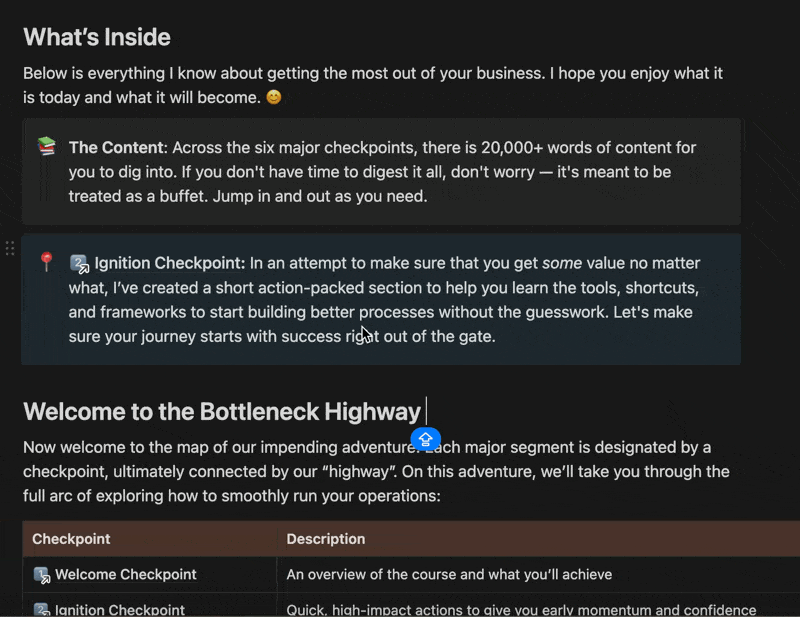Not subscribed? Sign up to get it in your inbox every week.

⚙ Hi {{first_name_tally|Operator}} — it’s Rameel
They say patience is a virtue.
That’s probably true… unless you’re waiting on your team to ship something.
- Rameel

PRESENTED BY THE BOTTLENECK
Your boss thinks you're "solid." But solid doesn't get promoted
Your calendar is full. Your brain is fried. And somehow, your work still flies under the radar.
The problem? You're drowning in tasks that should be automated. While you update spreadsheets, someone else is solving strategic problems. Bottleneck Breakers unlocks your escape velocity like:
– Convert job applications into Google Calendar interviews—automatically
– Build AI chatbots that handle customer FAQs while you sleep
– Deploy our Meeting Elimination Playbook and reclaim 20 hours per week
Access 40+ battle-tested frameworks that make executives finally see you as strategic 🧠
Everything's in Notion. Copy, paste, customize.
Watch three wins happen in your first month or your money back.
Thanks to our sponsors who keep this email free. Interested in sponsoring these emails? See our partnership options here

Hire for loyalty, not LinkedIn upgrades
The account manager I hired in February 2020 quit 30 days later.
I'd just launched a fuel logistics company. Door-to-door sales was the entire business model. This guy had the experience, knew the territory, should've been perfect.
Then COVID hit. Door-to-door became impossible overnight. Instead of figuring it out with us, he bailed. Left me and my co-founder scrambling to understand an entire market we barely knew while watching our company bleed out.
That hire cost me more than salary. It cost me momentum, time, and nearly the company itself. Turns out I'm not alone.
Replacing a bad hire costs anywhere from 100-150% of their annual salary, and that's just the direct costs. Factor in lost productivity and team disruption, and some experts peg it at 5-27 times their salary.
I learned something that day: the most expensive employees aren't the ones you pay the most. They're the ones who bail when you need them most.
The gold standard
My dad learned this lesson the hard way in the mid-2010s, during his biggest financial crisis. He had about 20 employees across his gas station business. Cash flow dried up. The books were bleeding red.
Within months, nineteen of them were gone.
Except his chief of staff.
This guy kept showing up—first in, last out—for two years without a paycheck. He handled negotiations, recruited new team members, ran operations, even did grocery runs when needed.
When my dad offered to help him find another job for the sake of his family, he refused.
"I'm not going anywhere," he said.

the legend himself (probably)
Today, that chief of staff is my dad's business partner and one of his closest friends. And the other nineteen? Who knows where they are.
The difference wasn't skills or experience. It was survival instincts.
The numbers back this up: companies with retention rates above 95% achieve 21% higher profitability than their high-turnover competitors.
McKinsey found that employee churn costs median S&P 500 companies between $228-355 million annually.
Meanwhile, 43.98% of employee turnovers happen within the first six months. Most companies lose their training investment before seeing any return.
Why we keep missing it
Here's what fools most operators: we're hiring for LinkedIn profiles instead of real people.
The LinkedIn mirage is everywhere. I've watched people delete positions, merge roles, and inflate titles to look more stable than they actually are. Tenure on a profile is marketing, not reality. People literally edit their job history to hide the fact that they're serial job-hoppers.
And job-hopping is getting worse. 37% of hiring managers now consider frequent job changes a red flag, but the behavior continues. The median job tenure has dropped to just 3.9 years—the lowest since 2002. Gen Z workers average only 1.3 years per position.
Then there's the title trap. I once hired a "former head of growth" from a public company. Impressive resume. Big company logo. Should've been a slam dunk.
Turns out he was a manager of managers who couldn't actually run growth metrics or build systems. When we started doing back references, we realized he'd never touched the nitty-gritty work. He just managed people who did.
We fired him and hired a growth optimizer instead. Someone with high velocity and deep experience who could actually execute, not just delegate.
The pattern is everywhere: we get distracted by credentials while missing character.
How to find loyalty
My dad didn't hire his chief of staff for his resume. He hired him for his character. When this guy moved from New York to Houston, my dad did something most operators skip: deep backchannel referencing.
He called people who'd worked with this guy for over a decade. Not just recent managers, but people who'd seen him through good times and bad. The question wasn't "How are his skills?" It was "When things got tough, how did he respond?"
The answers told the story: this guy had run his own business in New York for 10 years. Stuck with it through the hard parts. Only moved to Houston to be closer to family, not for money or a better opportunity.
Past loyalty predicts future loyalty.
The research proves this out: employee referrals have 47% three-year retention rates versus only 14% for job board hires.
Why though? Because referred candidates come pre-vetted for character by people who actually know them. They're not optimizing their LinkedIn profile, but they're being vouched for by someone who's seen their work ethic.
Here's what actual loyalty looks like in practice:
Test for adversity early. Give candidates a real, messy challenge during the interview process. See how they operate when it's hard.
Probe for past loyalty moments. Ask for specific examples of times they stayed when leaving was easier.
Look for quiet compounding. Long-term impact in past roles without constant title-chasing or job-hopping every 18 months.
Don't hire anyone you haven't seen operate under stress.
The operator's rules
After watching my dad's crisis and living through my own hiring disasters, here are the rules that actually work:
1. Repel tourists. Make the grind clear upfront so the wrong people self-select out. Don't sugarcoat what the job actually requires.
2. Test worst-day behavior. Every hire should be stress-tested. You want to see how they respond when things go sideways, not just when everything's running smoothly.
3. Don't outsource judgment to LinkedIn. Profiles are marketing copy. Back-channel references from people who've worked with them for years tell the real story.
4. Hire for what you need today. Not the brand someone once worked for or the title they held at a company you've heard of.
Why it matters
Think about those two stories: the account manager who bailed in February 2020 before making any impact, and the chief of staff who worked without pay for two years to keep the business alive.
Skills help you win a deal. Loyalty keeps you in the game long enough to build a business.
The operators who survive downturns aren't the ones with the best LinkedIn profiles—they're the ones with survival instincts.
They show up when the lights go out.
They stick around when the paycheck stops.
They do admin work if that's what the company needs.
You can't fake that kind of character. But you can learn to recognize it.
The question isn't whether someone can do the job. It's whether they'll still be there when you need them most.






